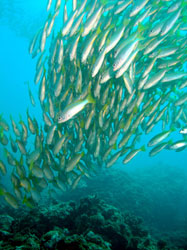Satellite data to estimate oceanic chlorophyll
The North Sea is home to some of Europe's richest fishing grounds. The fish rely on phytoplankton as their basic food source, so ensuring a healthy future for the fishing industry entails close monitoring of phytoplankton activity. In contrast, and equally important, chlorophyll is an important water quality parameter and is indicative of algal blooms that can be harmful, primarily in coastal waters. To this end, the REVAMP project, funded through the Fifth Framework Programme, aimed to exploit data from the Medium Resolution Imaging Spectrometer (MERIS) aboard the Earth-observing satellite Envisat. More specifically, reflectance data collected by MERIS is fed to a water quality algorithm to retrieve measurements of chlorophyll-a (CHL), a primary indicator of phytoplankton health. The research was led by the University of Oslo, which moved beyond previous simplistic approaches and implemented the Hydrolight radiative transfer code. The code accounts for all relevant optical phenomena, including reflectance, absorption, scattering and transmission. Subsequently, the Levenberg-Marquardt non-linear optimisation scheme is applied and modelled data are fit to observations. The advantages of the REVAMP solution include speed, thanks to high degree polynomial approximation techniques, and straightforward calibration. Furthermore, a measure of the quality of any particular set of CHL concentrations produced by the algorithm lets users know how well the model is performing. During REVAMP, the algorithm was used to map CHL throughout the North Sea. The University of Oslo is now seeking copyright protection for the new algorithm.



